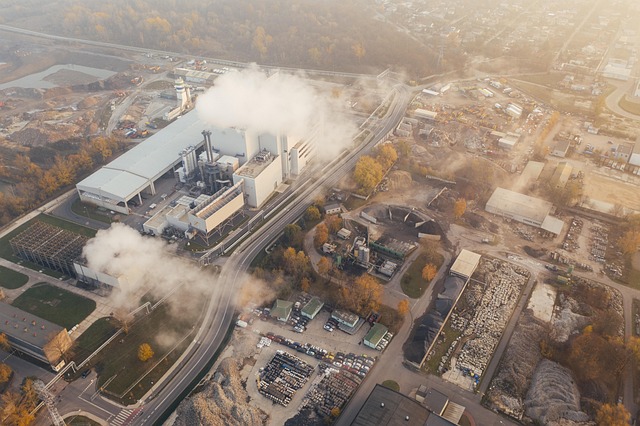Understanding your business's emission scope is key to effective environmental reporting. Companies must differentiate between direct and indirect emissions, adhering to relevant global standards like GRI and TCFD or local regulations influenced by stringent policies. Accurate data collection through advanced tools, such as industrial emissions monitoring devices, is crucial for measuring GHG emissions from manufacturing and transportation activities. Calculating emission intensities using life cycle assessment (LCA) frameworks and technology-driven data analysis ensures precise reporting and informed decisions to reduce environmental impact. Compliance with select emissions regulations fosters continuous improvement, enabling businesses to optimize operations, implement air pollution control measures, and contribute to climate change mitigation while maintaining stewardship of the environment.
In today’s eco-conscious business landscape, accurate emission reporting is not just a regulatory requirement but also a strategic imperative. This comprehensive guide explores vital tips for businesses navigating complex emission reporting processes. From understanding your operational scope and choosing suitable reporting frameworks (including global standards vs. local regulations) to implementing data collection techniques and calculating emission intensities, we provide actionable insights. Additionally, discover best practices for compliance and continuous improvement to enhance your company’s environmental stewardship.
- Understanding Your Scope: Identify Direct and Indirect Emissions
- Choosing the Right Reporting Framework: Global Standards vs. Local Regulations
- Data Collection: Accurate Measurement and Verification Techniques
- Calculating and Reporting Emission Intensities: Methods and Tools
- Compliance and Continuous Improvement: Best Practices for Effective Reporting
Understanding Your Scope: Identify Direct and Indirect Emissions

Understanding your business’s emission scope is a crucial first step in effective reporting. Emissions can be categorized into direct and indirect types, both of which contribute to a company’s overall environmental impact. Direct emissions arise from activities within your industrial facility, such as the burning of fossil fuels for energy or transportation-related emissions. These are often easier to track and control through measures like implementing efficient combustion technologies, optimizing logistics operations, and adopting sustainable manufacturing practices.
Indirect or indirect emissions, however, come from broader business activities that aren’t direct sources but still have an environmental footprint. Examples include emissions from the production of purchased goods, transportation of materials and products, employee commuting, and even the energy consumption of your supply chain. To accurately report these, businesses must Select Emissions Regulations relevant to their operations and industry. This involves considering regulations on industrial facility exhaust controls, natural resource conservation laws, and urban air quality monitoring systems, among others, to ensure comprehensive coverage of both direct and indirect emissions.
Choosing the Right Reporting Framework: Global Standards vs. Local Regulations

When it comes to business emission reporting, choosing the right framework is paramount. Companies must consider whether to adhere to global standards or comply with local regulations. International bodies like the Global Reporting Initiative (GRI) and the Task Force on Climate-related Financial Disclosures (TCFD) offer comprehensive guidelines that facilitate consistent, comparable, and transparent reporting across borders. These global standards are particularly beneficial for multinational corporations operating in diverse markets.
However, many countries have also established their own emissions regulations, often influenced by stricter environmental emission policies and local pollution control initiatives. For instance, car exhaust gas regulations worldwide are becoming increasingly stringent, reflecting a commitment to enhancing air quality through green infrastructure for air quality. Businesses should therefore stay informed about both global standards and the evolving landscape of local climate change emission mitigation efforts to ensure full compliance and contribute to effective environmental governance.
Data Collection: Accurate Measurement and Verification Techniques

Accurate data collection is the cornerstone of effective business emission reporting. To achieve this, companies should implement robust measurement and verification techniques that align with relevant Select Emissions Regulations. This involves employing advanced industrial emissions monitoring tools to track greenhouse gas (GHG) emissions from various operations, such as manufacturing processes and transportation activities. By integrating these tools into their systems, businesses can gather precise data on emission sources, quantities, and trends, ensuring compliance with both domestic and international clean air legislation.
For instance, voluntary emissions reduction programs can leverage real-time monitoring data to set ambitious yet achievable targets for cutting carbon footprints. These programs not only foster a culture of sustainability within organizations but also contribute to global efforts in combating climate change. Additionally, transportation emissions control measures, such as optimizing logistics and adopting cleaner fuel sources, can significantly reduce emissions from the supply chain, making it an essential component of any comprehensive emission reporting strategy.
Calculating and Reporting Emission Intensities: Methods and Tools

Calculating and reporting emission intensities is a crucial aspect of business sustainability practices. To accurately measure your company’s environmental impact, it’s essential to understand how to select the appropriate emissions regulations and methodologies. Start by identifying relevant air quality standards interpretation guidelines from regulatory bodies like the EPA or EU Commission, which provide clear frameworks for categorizing and reporting emissions. These standards often dictate specific calculation methods, such as life cycle assessment (LCA), enabling you to accurately determine emission intensities across various business operations.
Leverage smart grid emission management tools and pollutant release inventory management systems to streamline the data collection and analysis process. These advanced technologies assist in tracking energy consumption patterns, identifying high-emitting areas, and providing real-time insights into your company’s carbon footprint. By integrating these smart grid emission management approaches, you can ensure precise and consistent reporting of emission intensities, facilitating informed decision-making for reducing environmental impact and adhering to evolving air quality standards interpretation.
Compliance and Continuous Improvement: Best Practices for Effective Reporting

Compliance with Select Emissions Regulations is a cornerstone of effective business emission reporting. Going beyond simple adherence, adopting best practices fosters continuous improvement in environmental performance. Companies should implement robust internal processes to ensure data accuracy and transparency, aligning with industry standards and global initiatives like stringent automotive emissions rules. Regular reviews and updates to these processes are crucial, especially as global warming emission targets become more ambitious.
Integrating environmental impact assessments for industry into reporting mechanisms allows businesses to identify areas for optimization. By evaluating the full scope of their operations, from production to distribution, companies can implement targeted air pollution control techniques, contributing to a collective effort to mitigate climate change and its associated risks. This proactive approach not only supports regulatory compliance but also positions businesses as responsible stewards of the environment in light of growing global warming emission restrictions.
Emission reporting is a complex yet vital process for businesses aiming to navigate the landscape of environmental regulations, such as the Select Emissions Regulations. By understanding your scope, choosing the right framework, implementing robust data collection methods, and adopting best practices for compliance, you can ensure accurate and effective business emission reporting. This comprehensive approach not only facilitates regulatory adherence but also fosters continuous improvement in sustainability efforts.
